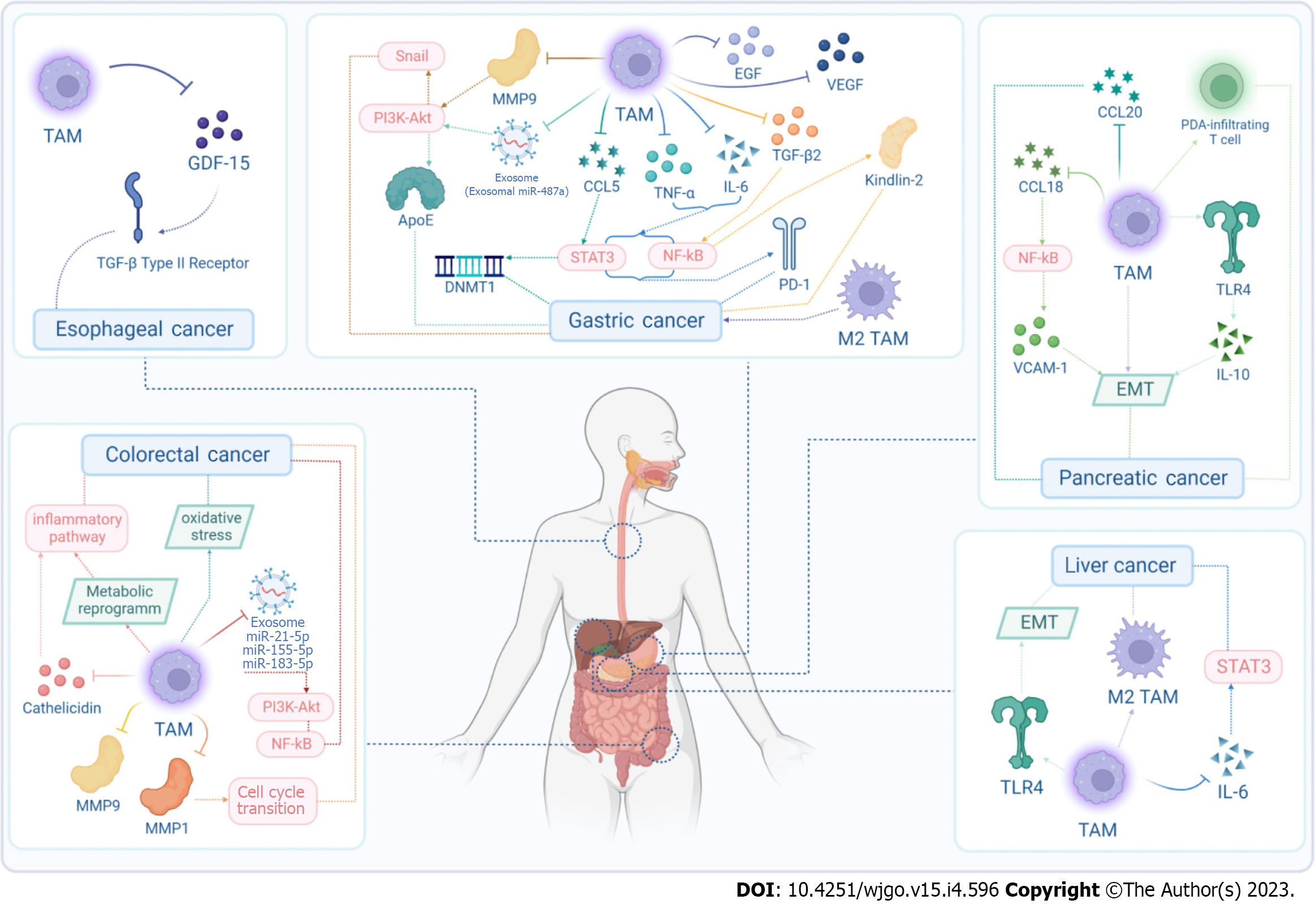Copyright
©The Author(s) 2023.
World J Gastrointest Oncol. Apr 15, 2023; 15(4): 596-616
Published online Apr 15, 2023. doi: 10.4251/wjgo.v15.i4.596
Published online Apr 15, 2023. doi: 10.4251/wjgo.v15.i4.596
Figure 1 Tumor-associated macrophages can promote the development of tumors.
Tumor-associated macrophages (TAMs) can affect cancer progression through multiple mechanisms, which are varying in esophageal cancer (EC), gastric cancer (GC), colorectal cancer (CRC), pancreatic cancer (PC), liver cancer (LC). Color differences indicate various strategies the TAMs use on their targets, the arrows represent secretory or regulatory behaviors, and braces represent combined action of the factors. Moreover, the pink icons stand for common signaling pathways and the green icons, biological processes. In EC, growth/differentiation factor-15 and transforming growth factor-beta receptor are involved in regulations. In GC, stimulation with anti-inflammatory triggers, growth factors, chemokine, exosomes and enzymes, leads to expression of transcription factors. In CRC, TAMs work with exosomes, matrix metalloproteinases and cathelicidin, concerning signaling pathways, cell cycle transition, metabolic reprogram, inflammatory pathways and oxidative stress. In PC and LC, TAMs regulate their development similarly through interleukins and Toll like receptor 4, leading to activation of transcription factors and epithelial mesenchymal transition of tumors. Thus, TAMs can regulate digestive system malignant tumors by diverse direct and indirect mechanisms. TAM: Tumor-associated macrophages; GDF-15: Growth/differentiation factor-15; TGF-β: Transforming growth factor-β; PI3K: Phosphoinositide 3-kinase; MMP9: Matrix metalloproteinases 9; EGF: Epidermal growth factor; VEGF: Vascular endothelial growth factor; CCL5: CC ligand 5; TNF-α: Tumor necrosis factor-α; IL: Interleukin; STAT3: Signal transducers and activator of transcription 3; NF-kB: Nuclear factor kB; PD-1: Programmed death 1; PDA: Pancreatic ductal adenocarcinoma; TLR4: Toll like receptor 4; VCAM: Vascular cellular adhesion molecule-1; EMT: Epithelial mesenchymal transition; DNMT1: DNA methyltransferase 1.
Figure 2 Tumor-associated macrophages act as potential therapeutic targets for tumors.
Multifarious strategies for modulation of tumor-associated macrophages (TAMs) are unveiled for therapeutic applications, which are varying in different digestive system malignant tumors. Color differences indicate various approaches to regulate TAMs’ behaviors, the arrows represent secretory or regulatory behaviors, and braces represent combined action of the factors. Moreover, the pink icons stand for common signaling pathways, the green icons stand for biological processes, and the purple icons stand for different reactions of TAMs, including TAMs’ polarization, activation, recruitment, trafficking, infiltration, transcription, and so on. Tumor and immune cells secrete growth factors, cytokines, chemokines, metabolites and extracellular vesicles that promote TAM protumor polarization. Besides, RNA, virus and specific cells also exert influence on TAM plasticity and activation. Several key signaling pathways are involved in these regulation processes, including phosphoinositide 3-kinase-Akt-mammalian target of rapamycin, nuclear factor kB, stimulator of interferon genes, and so on. Thus, TAMs can act as a promising potential therapeutic target for digestive system malignant tumors. NCAM: Neural cell adhesion molecule; FGF-2: Fibroblast growth factor 2; ATF3: Activation transcription factor 3; TAM: Tumor-associated macrophages; PI3K: Phosphoinositide 3-kinase; HPV: Human papillomavirus; STAT3: Signal transducers and activator of transcription 3; STING: Stimulator of interferon genes; IL: Interleukin; TNF-α: Tumor necrosis factor-α; VEGF: Vascular endothelial growth factor; mTOR: Mammalian target of rapamycin; iNOS: Inducible nitric oxide synthase; NF-kB: Nuclear factor kB; MAGL: Monoacylglycerol lipase; TREM: Triggering receptors expressed on myeloid cells; EMT: Epithelial mesenchymal transition; EGF: Epidermal growth factor; HSC: Hematopoietic stem cell; GARP: Glycoprotein A repetitions predominant; IFN-γ: Interferon-γ; EVs: Extracellular vesicles; CCL: CC ligand; PTEN: Phosphatase and tensin homolog.
- Citation: Shen Y, Chen JX, Li M, Xiang Z, Wu J, Wang YJ. Role of tumor-associated macrophages in common digestive system malignant tumors. World J Gastrointest Oncol 2023; 15(4): 596-616
- URL: https://www.wjgnet.com/1948-5204/full/v15/i4/596.htm
- DOI: https://dx.doi.org/10.4251/wjgo.v15.i4.596










